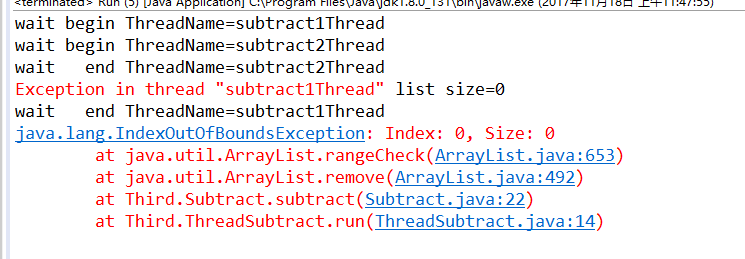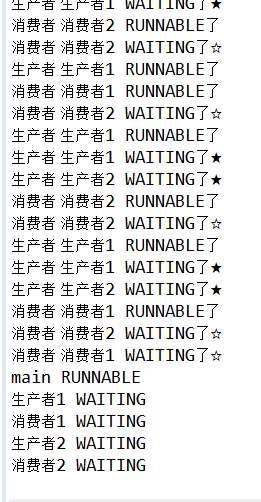当interrupt方法遇到wait方法
当线程呈wait()状态时,调用线程对象的interrupt()会出现InterruptedException异常
package Third; public class Service { public void testMethod(Object lock) { try { synchronized (lock) { System.out.println("begin wait()"); lock.wait(); System.out.println(" end wait()"); } } catch (InterruptedException e) { e.printStackTrace(); System.out.println("出现异常了,因为呈wait状态的线程被interrupt了!"); } } }
package Third; public class ThreadA extends Thread { private Object lock; public ThreadA(Object lock) { super(); this.lock = lock; } @Override public void run() { Service service = new Service(); service.testMethod(lock); } }
package Third; public class Test { public static void main(String[] args) { try { Object lock = new Object(); ThreadA a = new ThreadA(lock); a.start(); Thread.sleep(5000); a.interrupt(); } catch (InterruptedException e) { e.printStackTrace(); } } }


只通知一个线程
调用方法notify()一次只随机通知一个线程进行唤醒
package Third; public class Service { public void testMethod(Object lock) { try { synchronized (lock) { System.out.println("begin wait() ThreadName=" + Thread.currentThread().getName()); lock.wait(); System.out.println(" end wait() ThreadName=" + Thread.currentThread().getName()); } } catch (InterruptedException e) { e.printStackTrace(); } } }
package Third; public class ThreadA extends Thread { private Object lock; public ThreadA(Object lock) { super(); this.lock = lock; } @Override public void run() { Service service = new Service(); service.testMethod(lock); } }
package Third; public class ThreadB extends Thread { private Object lock; public ThreadB(Object lock) { super(); this.lock = lock; } @Override public void run() { Service service = new Service(); service.testMethod(lock); } }
package Third; public class ThreadC extends Thread { private Object lock; public ThreadC(Object lock) { super(); this.lock = lock; } @Override public void run() { Service service = new Service(); service.testMethod(lock); } }
package Third; public class NotifyThread extends Thread { private Object lock; public NotifyThread(Object lock) { super(); this.lock = lock; } @Override public void run() { synchronized (lock) { lock.notify(); } } }
package Third; public class Test { public static void main(String[] args) throws InterruptedException { Object lock = new Object(); ThreadA a = new ThreadA(lock); a.start(); ThreadB b = new ThreadB(lock); b.start(); ThreadC c = new ThreadC(lock); c.start(); Thread.sleep(1000); NotifyThread notifyThread = new NotifyThread(lock); notifyThread.start(); } }


唤醒所有线程
package Third; public class NotifyThread extends Thread { private Object lock; public NotifyThread(Object lock) { super(); this.lock = lock; } @Override public void run() { synchronized (lock) { lock.notifyAll(); } } }

wait(long)的使用
功能是等待某一时间内是否有线程对锁进行唤醒,如果超过这个时间则自动唤醒

当然也可以由其他线程进行唤醒
package Third; public class MyRunnable { static private Object lock = new Object(); static private Runnable runnable1 = new Runnable() { @Override public void run() { try { synchronized (lock) { System.out.println("wait begin timer=" + System.currentTimeMillis()); lock.wait(5000); System.out.println("wait end timer=" + System.currentTimeMillis()); } } catch (InterruptedException e) { e.printStackTrace(); } } }; static private Runnable runnable2 = new Runnable() { @Override public void run() { synchronized (lock) { System.out.println("notify begin timer=" + System.currentTimeMillis()); lock.notify(); System.out.println("notify end timer=" + System.currentTimeMillis()); } } }; public static void main(String[] args) throws InterruptedException { Thread t1 = new Thread(runnable1); t1.start(); Thread.sleep(3000); Thread t2 = new Thread(runnable2); t2.start(); } }

通知过早
package Third; public class MyRun { private String lock = new String(""); private Runnable runnableA = new Runnable() { @Override public void run() { try { synchronized (lock) { System.out.println("begin wait"); lock.wait(); System.out.println("end wait"); } } catch (InterruptedException e) { e.printStackTrace(); } } }; private Runnable runnableB = new Runnable() { @Override public void run() { synchronized (lock) { System.out.println("begin notify"); lock.notify(); System.out.println("end notify"); } } }; public static void main(String[] args) throws InterruptedException { MyRun run = new MyRun(); Thread a = new Thread(run.runnableA); a.start(); Thread b = new Thread(run.runnableB); b.start(); } }

package Third; public class MyRun { private String lock = new String(""); private Runnable runnableA = new Runnable() { @Override public void run() { try { synchronized (lock) { System.out.println("begin wait"); lock.wait(); System.out.println("end wait"); } } catch (InterruptedException e) { e.printStackTrace(); } } }; private Runnable runnableB = new Runnable() { @Override public void run() { synchronized (lock) { System.out.println("begin notify"); lock.notify(); System.out.println("end notify"); } } }; public static void main(String[] args) throws InterruptedException { MyRun run = new MyRun(); Thread a = new Thread(run.runnableA); a.start(); Thread.sleep(100); Thread b = new Thread(run.runnableB); b.start(); } }

如果先通知了,则wait方法也就没有必要执行了
package Third; public class MyRun { private String lock = new String(""); private boolean isFirstRunB = false; private Runnable runnableA = new Runnable() { @Override public void run() { try { synchronized (lock) { while (isFirstRunB == false) { System.out.println("begin wait"); lock.wait(); System.out.println("end wait"); } } } catch (InterruptedException e) { e.printStackTrace(); } } }; private Runnable runnableB = new Runnable() { @Override public void run() { synchronized (lock) { System.out.println("begin notify"); lock.notify(); System.out.println("end notify"); isFirstRunB = true; } } }; public static void main(String[] args) throws InterruptedException { MyRun run = new MyRun(); Thread b = new Thread(run.runnableB); b.start(); Thread.sleep(100); Thread a = new Thread(run.runnableA); a.start(); } }

等待wait条件发生变化
在使用wait/notify模式时,还需要注意另外一种情况。也就是wait等待的条件发生了变化,也容易造成程序逻辑混乱
package Third; public class Add { private String lock; public Add(String lock) { super(); this.lock = lock; } public void add() { synchronized (lock) { ValueObject.list.add("anyString"); lock.notifyAll(); } } }
package Third; public class Subtract { private String lock; public Subtract(String lock) { super(); this.lock = lock; } public void subtract() { try { synchronized (lock) { if (ValueObject.list.size() == 0) { System.out.println("wait begin ThreadName=" + Thread.currentThread().getName()); lock.wait(); System.out.println("wait end ThreadName=" + Thread.currentThread().getName()); } ValueObject.list.remove(0); System.out.println("list size=" + ValueObject.list.size()); } } catch (InterruptedException e) { e.printStackTrace(); } } }
package Third; import java.util.ArrayList; import java.util.List; public class ValueObject { public static List list = new ArrayList(); }
package Third; public class ThreadAdd extends Thread { private Add p; public ThreadAdd(Add p) { super(); this.p = p; } @Override public void run() { p.add(); } }
package Third; public class ThreadSubtract extends Thread { private Subtract r; public ThreadSubtract(Subtract r) { super(); this.r = r; } @Override public void run() { r.subtract(); } }
package Third; public class Run { public static void main(String[] args) throws InterruptedException { String lock = new String(""); Add add = new Add(lock); Subtract subtract = new Subtract(lock); ThreadSubtract subtract1Thread = new ThreadSubtract(subtract); subtract1Thread.setName("subtract1Thread"); subtract1Thread.start(); ThreadSubtract subtract2Thread = new ThreadSubtract(subtract); subtract2Thread.setName("subtract2Thread"); subtract2Thread.start(); Thread.sleep(1000); ThreadAdd addThread = new ThreadAdd(add); addThread.setName("addThread"); addThread.start(); } }


package Third; public class Subtract { private String lock; public Subtract(String lock) { super(); this.lock = lock; } public void subtract() { try { synchronized (lock) { while (ValueObject.list.size() == 0) { System.out.println("wait begin ThreadName=" + Thread.currentThread().getName()); lock.wait(); System.out.println("wait end ThreadName=" + Thread.currentThread().getName()); } ValueObject.list.remove(0); System.out.println("list size=" + ValueObject.list.size()); } } catch (InterruptedException e) { e.printStackTrace(); } } }

生产者/消费者模式实现
1、一生产与一消费:操作值
package Third; //生产者 public class P { private String lock; public P(String lock) { super(); this.lock = lock; } public void setValue() { try { synchronized (lock) { if (!ValueObject.value.equals("")) { lock.wait(); } String value = System.currentTimeMillis() + "_" + System.nanoTime(); System.out.println("set的值是" + value); ValueObject.value = value; lock.notify(); } } catch (InterruptedException e) { e.printStackTrace(); } } }
package Third; //消费者 public class C { private String lock; public C(String lock) { super(); this.lock = lock; } public void getValue() { try { synchronized (lock) { if (ValueObject.value.equals("")) { lock.wait(); } System.out.println("get的值是" + ValueObject.value); ValueObject.value = ""; lock.notify(); } } catch (InterruptedException e) { e.printStackTrace(); } } }
package Third; public class ValueObject { public static String value = ""; }
package Third; public class ThreadP extends Thread { private P p; public ThreadP(P p) { super(); this.p = p; } @Override public void run() { while (true) { p.setValue(); } } }
package Third; public class ThreadC extends Thread { private C r; public ThreadC(C r) { super(); this.r = r; } @Override public void run() { while (true) { r.getValue(); } } }
package Third; public class Run { public static void main(String[] args) { String lock = new String(""); P p = new P(lock); C r = new C(lock); ThreadP pThread = new ThreadP(p); ThreadC rThread = new ThreadC(r); pThread.start(); rThread.start(); } }

在控制台中打印的日志get和set是交替运行的
2、多生产与多消费:操作值-假死
“”假死“”的现象其实就是线程进入waiting等待状态,如果全部线程都进入waiting状态,则程序就不再执行任何业务功能了,整个项目呈停止状态
package Third; //消费者 public class C { private String lock; public C(String lock) { super(); this.lock = lock; } public void getValue() { try { synchronized (lock) { while (ValueObject.value.equals("")) { System.out.println("消费者 " + Thread.currentThread().getName() + " WAITING了☆"); lock.wait(); } System.out.println("消费者 " + Thread.currentThread().getName() + " RUNNABLE了"); ValueObject.value = ""; lock.notify(); } } catch (InterruptedException e) { e.printStackTrace(); } } }
package Third; //生产者 public class P { private String lock; public P(String lock) { super(); this.lock = lock; } public void setValue() { try { synchronized (lock) { while (!ValueObject.value.equals("")) { System.out.println("生产者 " + Thread.currentThread().getName() + " WAITING了★"); lock.wait(); } System.out.println("生产者 " + Thread.currentThread().getName() + " RUNNABLE了"); String value = System.currentTimeMillis() + "_" + System.nanoTime(); ValueObject.value = value; lock.notify(); } } catch (InterruptedException e) { e.printStackTrace(); } } }
package Third; public class ValueObject { public static String value = ""; }
package Third; public class ThreadP extends Thread { private P p; public ThreadP(P p) { super(); this.p = p; } @Override public void run() { while (true) { p.setValue(); } } }
package Third; public class ThreadC extends Thread { private C r; public ThreadC(C r) { super(); this.r = r; } @Override public void run() { while (true) { r.getValue(); } } }
package Third; public class Run { public static void main(String[] args) throws InterruptedException { String lock = new String(""); P p = new P(lock); C r = new C(lock); ThreadP[] pThread = new ThreadP[2]; ThreadC[] rThread = new ThreadC[2]; for (int i = 0; i < 2; i++) { pThread[i] = new ThreadP(p); pThread[i].setName("生产者" + (i + 1)); rThread[i] = new ThreadC(r); rThread[i].setName("消费者" + (i + 1)); pThread[i].start(); rThread[i].start(); } Thread.sleep(5000); Thread[] threadArray = new Thread[Thread.currentThread() .getThreadGroup().activeCount()]; Thread.currentThread().getThreadGroup().enumerate(threadArray); for (int i = 0; i < threadArray.length; i++) { System.out.println(threadArray[i].getName() + " " + threadArray[i].getState()); } } }


假死出现的主要原因是有可能连续唤醒同类
多生产与多消费:操作值
将上面项目的P.java和C.java文件中的notify()改成notifyAll()即可,不光通知同类线程,也包括异类